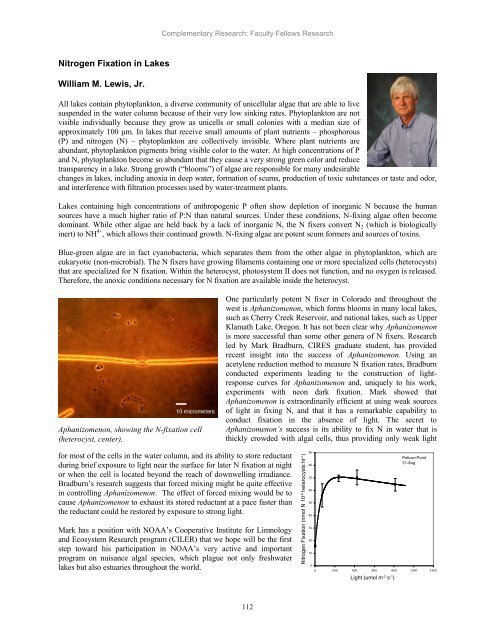Scientific Theme: Advanced Modeling and Observing Systems
Scientific Theme: Advanced Modeling and Observing Systems
Scientific Theme: Advanced Modeling and Observing Systems
You also want an ePaper? Increase the reach of your titles
YUMPU automatically turns print PDFs into web optimized ePapers that Google loves.
Nitrogen Fixation in Lakes<br />
William M. Lewis, Jr.<br />
Complementary Research: Faculty Fellows Research<br />
All lakes contain phytoplankton, a diverse community of unicellular algae that are able to live<br />
suspended in the water column because of their very low sinking rates. Phytoplankton are not<br />
visible individually because they grow as unicells or small colonies with a median size of<br />
approximately 100 μm. In lakes that receive small amounts of plant nutrients – phosphorous<br />
(P) <strong>and</strong> nitrogen (N) – phytoplankton are collectively invisible. Where plant nutrients are<br />
abundant, phytoplankton pigments bring visible color to the water. At high concentrations of P<br />
<strong>and</strong> N, phytoplankton become so abundant that they cause a very strong green color <strong>and</strong> reduce<br />
transparency in a lake. Strong growth (―blooms‖) of algae are responsible for many undesirable<br />
changes in lakes, including anoxia in deep water, formation of scums, production of toxic substances or taste <strong>and</strong> odor,<br />
<strong>and</strong> interference with filtration processes used by water-treatment plants.<br />
Lakes containing high concentrations of anthropogenic P often show depletion of inorganic N because the human<br />
sources have a much higher ratio of P:N than natural sources. Under these conditions, N-fixing algae often become<br />
dominant. While other algae are held back by a lack of inorganic N, the N fixers convert N2 (which is biologically<br />
inert) to NH 4+ , which allows their continued growth. N-fixing algae are potent scum formers <strong>and</strong> sources of toxins.<br />
Blue-green algae are in fact cyanobacteria, which separates them from the other algae in phytoplankton, which are<br />
eukaryotic (non-microbial). The N fixers have growing filaments containing one or more specialized cells (heterocysts)<br />
that are specialized for N fixation. Within the heterocyst, photosystem II does not function, <strong>and</strong> no oxygen is released.<br />
Therefore, the anoxic conditions necessary for N fixation are available inside the heterocyst.<br />
Aphanizomenon, showing the N-fixation cell<br />
(heterocyst, center).<br />
for most of the cells in the water column, <strong>and</strong> its ability to store reductant<br />
during brief exposure to light near the surface for later N fixation at night<br />
or when the cell is located beyond the reach of downwelling irradiance.<br />
Bradburn‘s research suggests that forced mixing might be quite effective<br />
in controlling Aphanizomenon. The effect of forced mixing would be to<br />
cause Aphanizomenon to exhaust its stored reductant at a pace faster than<br />
the reductant could be restored by exposure to strong light.<br />
Mark has a position with NOAA‘s Cooperative Institute for Limnology<br />
<strong>and</strong> Ecosystem Research program (CILER) that we hope will be the first<br />
step toward his participation in NOAA‘s very active <strong>and</strong> important<br />
program on nuisance algal species, which plague not only freshwater<br />
lakes but also estuaries throughout the world.<br />
One particularly potent N fixer in Colorado <strong>and</strong> throughout the<br />
west is Aphanizomenon, which forms blooms in many local lakes,<br />
such as Cherry Creek Reservoir, <strong>and</strong> national lakes, such as Upper<br />
Klamath Lake, Oregon. It has not been clear why Aphanizomenon<br />
is more successful than some other genera of N fixers. Research<br />
led by Mark Bradburn, CIRES graduate student, has provided<br />
recent insight into the success of Aphanizomenon. Using an<br />
acetylene reduction method to measure N fixation rates, Bradburn<br />
conducted experiments leading to the construction of lightresponse<br />
curves for Aphanizomenon <strong>and</strong>, uniquely to his work,<br />
experiments with neon dark fixation. Mark showed that<br />
Aphanizomenon is extraordinarily efficient at using weak sources<br />
of light in fixing N, <strong>and</strong> that it has a remarkable capability to<br />
conduct fixation in the absence of light. The secret to<br />
Aphanizomenon’s success is its ability to fix N in water that is<br />
thickly crowded with algal cells, thus providing only weak light<br />
112<br />
Nitrogen Fixation (nmol N 10 -6 heterocysts hr -1 )<br />
90<br />
80<br />
70<br />
60<br />
50<br />
40<br />
30<br />
20<br />
10<br />
0<br />
Pelican Pond<br />
31-Aug<br />
0 200 400 600 800 1000 1200<br />
Light (umol m -2 s -1 )
















